Moisture is a common attractant for various pests, creating an environment that supports their survival and proliferation. Whether it’s in homes, gardens, or commercial spaces, excessive moisture can provide a breeding ground for pests, leading to potential health hazards and property damage. Understanding which pests are drawn to moisture is essential for effective pest management and prevention strategies. In this article, we will explore some of the most common pests that are attracted to moisture and how to mitigate their presence.
What Pests Are Attracted to Moisture?
There are different kinds of pests attracted to moisture. Let’s see every one of them and their preventive measures.
Mosquitoes

Mosquitoes are notorious for their attraction to standing water, which serves as a prime breeding ground for their larvae. Even small puddles, bird baths, clogged gutters, and containers that hold water for more than a few days can become mosquito breeding sites. Female mosquitoes lay their eggs on the water’s surface, and the larvae develop in the water until they mature into adult mosquitoes. These pesky insects are irritating and can transmit diseases such as West Nile virus, dengue, and malaria.
Preventive Measure
Regularly remove standing water from containers, gutters, and other potential breeding sites. Keep water features well-maintained, or consider using products like mosquito dunks that release bacteria toxic to mosquito larvae.
Cockroaches
Cockroaches are adaptable pests that thrive in damp, dark environments. They are commonly found in kitchens, bathrooms, and basements, attracted to leaking pipes, condensation, and high humidity levels. These resilient insects can spread bacteria and trigger allergies and asthma in some individuals.
Preventive Measure
Fix any leaks or plumbing issues promptly. Use dehumidifiers in damp areas to reduce humidity levels. Keep kitchens clean, and store food in sealed containers to avoid attracting cockroaches.
Termites

Termite infestations are particularly drawn to moisture as they require it for their survival. They build mud tubes to access sources of moisture and feed on damp or water-damaged wood. These silent destroyers can cause significant structural damage to buildings and other wooden structures.
Preventive Measure
Repair any leaks or water damage promptly. Ensure proper drainage around the foundation of the building. Regularly inspect wooden structures for signs of termite infestation.
Snails and Slugs
These slimy pests are strongly attracted to moisture and thrive in damp gardens and flowerbeds. They can cause significant damage to plants, especially young seedlings and foliage.
Preventive Measure
Remove debris and mulch from around plants, as they provide hiding spots for snails and slugs. Consider using barriers or traps to protect plants from these pests.
Rodents

Rodents like mice and rats are attracted to moisture because they need water to survive. They usually build their nests near sources of water, so fixing leaks and drying out damp areas can prevent them from nesting in your home.
Preventive Measure
Inspect your property for any cracks, gaps, or holes in doors, windows, walls, and foundations. Seal them using caulk, wire mesh, or steel wool to prevent rodents from gaining access. Store food in airtight containers, particularly grains, cereals, and pet food. Ensure tightly sealed garbage cans, and promptly clean up any food spills or crumbs.
Conclusion
Moisture is a magnet for various pests, making it essential for homeowners and businesses to take proactive measures to eliminate standing water, fix leaks, and maintain proper ventilation. Regular inspections with pest control services can go a long way in keeping these pests at bay and ensuring a pest-free environment.






